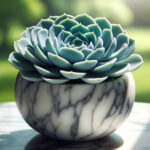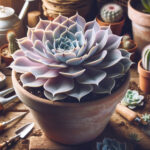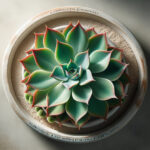Welcome to our comprehensive guide about one of the most striking and engaging succulents out there – the Echeveria Desmetiana! If you have a thing for plants, and, in particular, succulents, then you’re certainly in the right place. Known for its textured, rose-like appearance and a keen ability to jazz up any space, the Echeveria Desmetiana is worth exploring.
What is Echeveria Desmetiana?
Let’s cut to the chase. Echeveria Desmetiana, often referred to as the ‘Desmetiana Echeveria,’ is a type of flowering succulent plant from the Echeveria genus, part of the larger, fascinating Crassulaceae family. Now, if you’re wondering what exactly a succulent is, it’s a type of plant with parts that are thickened, engorged, apt to retain water—in deserts or arid soil conditions. And there’s a good reason why the Echeveria Desmetiana succulent stands out among the crowd!
A Peek into the Plant Kingdom
Now, you might be asking, “Where exactly does this striking Echeveria Desmetiana fit within the bigger picture of the plant kingdom?” Grooming up with vast flora-fauna, it holds an elegant position. This perennial succulent belongs to the division of flowering plants known as Angiosperms, nested in the order Saxifragales. Within that order, it falls within the Crassulaceae family – an amazing group of succulent plants that are known for their incredible adaptability to dry environments. Essentially, Echeveria Desmetiana, in its waxy leaves and fantastic flower-like form, is a testament to the adaptability and diversity that the plant kingdom proudly exhibits.
An Ode to Echeveria Desmetiana
In simple words, the Echeveria Desmetiana is a gem among succulents. You have to appreciate its easy-to-grow nature and its stunning appearance. Whether you are an experienced green thumb or a newbie gardener, the charm and beauty of this succulent can elevate your indoor or outdoor garden spaces to greater heights.
So sit back, keep scrolling, and let’s delve deeper into everything there is to learn about the wonderful world of Echeveria Desmetiana! And who knows? By the end of this guide, you might find yourself making space for this delightful succulent in your home or garden.
Let’s delve into the captivating tale of the unique origin and evolution of Echeveria Desmetiana! A tale that is not just of survival, but also of adaptation and continued thriving.
The Birthplace Of Echeveria Desmetiana
Like many a tale, the story of Echeveria Desmetiana starts in the exotic wilderness of Central America, more specifically, in the heartland of Mexico. This compact and fleshy succulent was born amidst the rugged landscapes characterized by an arid, rocky terrain and intense sunlight. This harsh, elemental environment played a significant role in sculpting this plant’s resilience and distinctive beauty.
Echeveria Desmetiana: On The Wings Of Human Curiosity
From its Mexican homeland, man’s insatiable curiosity and love for unique natural beauty saw it being transported to other parts of the world. Enthusiastic botanists and plant collectors played a vital role in the geographic expansion of this species. It wasn’t just the pretty face of Echeveria Desmetiana that found favor with plant lovers across continents. Its resilient nature, coupled with minimal caretaking needs, scored high among beginners and experts alike in the botanical world.
The Evolutionary Journey of Echeveria Desmetiana
As opposed to many plant species that undergo radical adaptations to cope with changing environments, Echeveria Desmetiana has largely retained its original qualities. The plant’s compact structure, succulent leaves, and the stunning reddish hues that grace the leaf tips during periods of strong sunlight, are all vintage features that it shares with its ancestral peers. Although it was primarily discovered in an arid landscape, its ability to endure a range of climates and conditions are a testament to its resilience and adaptability.
The Modern Day Echeveria Desmetiana
Today, Echeveria Desmetiana is widely adored by succulent aficionados all around the globe. From the professional greenhouses of Europe to the humble windowsills of Asia and North America, you’re likely to find this vibrant species adding a dash of color and charm. All the while, it holds onto its intrinsic features – a stunning testament to the power of evolution and adaptation over the ages.
So there you have it! From its humble beginnings in the parched landscapes of Mexico to its current global adoration, the journey of the Echeveria Desmetiana is as fascinating as its mesmerizing beauty. So the next time you water your Echeveria Desmetiana or gaze admiringly at those rosy-tipped leaves, just remember the remarkable journey it undertook to sit there, in your home, today.
Have you ever had one of those ‘aha!’ moments in your gardening journey? Well, buckle up, because you’re about to have another one. Let’s get real about the Echeveria Desmetiana. This succulent isn’t your average plant, and understanding its growth characteristics can make all the difference in your green thumb prowess.
Growth Size of Echeveria Desmetiana
Imagine a burger. Now, replace that juicy patty with a beautiful, plump rosette of flesh, arranged in neat spiraling circles. That’s your Echeveria Desmetiana in all its grandeur. This succulent typically grows up to six inches in diameter, with its rosette growing up to six inches tall too. But don’t let that fool you with its smaller body size. It’s flower spikes can reach a whopping twelve to eighteen inches tall when fully grown, making it a real show-stopper in any garden.
The Growth Pace of Echeveria Desmetiana
You know how some plants take their sweet time to grow, while others can’t seem to wait to shoot up? Well, your Echeveria Desmetiana is somewhat in-between. It exhibits moderate growth pace compared to its succulent counterparts. But here’s the key – providing optimal care can encourage faster growth, so get that green thumb working!
Optimal Growing Temperatures for Echeveria Desmetiana
If you’ve ever stepped out on a bright, summery day and thought, ‘This is the life,’ then you’ll understand how your Echeveria Desmetiana feels about temperature. These desert natives absolutely thrive between 20°C to 25°C (68°F to 77°F). Just remember, if you’re feeling a bit too warm or a little too cold, your Echeveria Desmetiana probably is too. So keep a weather eye out and adjust your plant care according to the climate.
So there you go! You’ve now gotten up close and personal with the growth characteristics of the ravishing Echeveria Desmetiana. Whether you’re an experienced gardener hunting for your next exotic plant or a newbie wanting to test your nurturing skills, this succulent is a top-notch choice. And remember, the right care makes for a happy plant. Here’s to your succulent success!
If you’re a fan of gardening and attractive plants, you’re probably no stranger to the enchanting Echeveria Desmetiana. This beautiful Mexican succulent is an ideal addition to any home garden or interior décor. However, like all succulents, it has its own preferences when it comes to soil, water and lighting. Understanding these can make a huge difference in how well your Echeveria Desmetiana thrives.
Soil Requirements for Echeveria Desmetiana
For starters, let’s chat about soil. It’s no secret that succulents love well-draining soil, and Echeveria Desmetiana is no exception. Think of it this way: this desert beauty is used to sandy, loose soil in its natural habitat. So, it makes sense that it doesn’t enjoy sitting in waterlogged soil or something too heavy. To keep your Echeveria Desmetiana happy, opt for a cactus mix or create your own blend with coarse sand, potting soil, and perlite or pumice.
Echeveria Desmetiana and Water: What’s the Deal?
Next up, water. Despite what you may think, Echeveria Desmetiana does not enjoy being constantly drenched in water like a fern or water lily. Over-watering is a fast track to rot and no one wants that! Its thick leaves store water and it prefers dry conditions. The best rule to follow? The soak and dry method. Fully soak the soil and then wait until it’s completely dry before watering again. Depending on your home’s humidity, this could be every 1 to 2 weeks.
Lighting Levels for Echeveria Desmetiana
Lastly, let’s shed some light on the subject – literally. Echeveria Desmetiana adores bright light. Picture it basking in the Mexican desert sun. However, too much direct sunlight can fry it like an egg in a pan. A spot near a window with filtered sunlight or an area with bright, indirect light is best. Consider it like finding the perfect shady spot on a sunny beach day. Enough sunshine to enjoy, but not so much as to risk a burn.
And there you have it! The key elements of soil, water, and light to ensure your Echeveria Desmetiana grows healthy and strong. Remember, just like any plant, Echeveria Desmetiana has its own unique needs. Take the time to understand them, and you’ll be rewarded with a gorgeous, thriving succulent. Happy gardening!
Potential Problems and Their Solutions
Okay, now I know that you’re eager to embark on the journey of growing the enchanted Echeveria Desmetiana. Perfect! But let’s first speak about the potential challenges you may face while trying to make it thrive. These might include attacks from those pesky pests, distressing diseases, and other plant health concerns. But don’t worry, I’ve got you covered with preventative measures and proactive solutions. Settle in; we’re about to do some myth-busting and problem-solving!
Pests That Bug Your Echeveria Desmetiana
You might have noticed some tiny yet irritating creatures feeding on your plant, detracting from its beauty. Aphids and mealybugs are the most common pests you’ll encounter while nursing an Echeveria Desmetiana. Aphids are tiny insects that suck the vitality out of your plant, while mealybugs appear as white, fuzzy spots that can quickly spread if left unattended.
So, how do you wage war against these foes? For a low infestation, a spray of room-temperature water can dislodge them. If the situation becomes Dante’s Inferno, a gentle soap or insecticidal spray could be your guardian angel. And for the heaviest infestations? Quarantine the plant and apply a systemic insecticide. But remember, prevention is key. Regularly inspect your plants and maintain a clean environment to deter any pest invasion.
Diseases That Threaten Your Green Acquaintance
Just like how we humans nip diseases in the bud, your Echeveria Desmetiana requires the same care. The most common disease affecting this variety is root rot. This troublemaker usually shows traits like yellowing, wilting, or drooping leaves. You’d be wise to keep in mind that overwatering and poor-draining soils are primary causes of this disease. You can tackle this by watering only when the soil is dry and using well-draining soil. In severe cases, repotting the plant while snipping off the diseased roots will give it a fresh lease of life.
Other Plant Health Concerns
Echeveria Desmetiana, like all beloved green friends, can face other general health concerns. These may include issues like inadequate sunlight, nutrition deficiency, or improper temperatures. Sun-stressed plants can turn an alien color, so ensure your plant receives at least 6 hours of bright, indirect sunlight daily. If your plant appears “starved” with slow growth or pale leaves, it might need a balanced, water-soluble fertilizer. With regards to temperature, this type thrives at 65-80°F (18-26°C) ‒ too much heat or cold can hamper the plant’s well-being.
Keep Calm and Garden On
All this chatter about potential problems shouldn’t deter you from exploring the wonderful world of Echeveria Desmetiana! Yet, being aware of these issues and their solutions is much like having an insurance policy. It equips you to swiftly counter any problems and ensure your plant’s overall health. So, go ahead and flex those green thumbs, knowing you’re well-prepared to bring your Echeveria Desmetiana to life.
Propagating and Reproducing Echeveria Desmetiana
If you’re a lover of succulents, then you’ve undoubtedly encountered the Echeveria Desmetiana — a beautifully vibrant plant that can brighten any room. But what if you’d like to share the joy with your friends, or simply want more of these stunning succulents around your home? Enter the art and science of propagation!
The Step-by-Step Guide to Echeveria Desmetiana Propagation
When it comes to Echeveria Desmetiana propagation, you can trust me on one thing. It’s easier than you think. You don’t need a green thumb, just a little bit of patience and understanding of the plant’s needs. So, let’s dive in!
Step 1: Preparing Your Leaf or Stem Cutting
The first step in your Echeveria Desmetiana propagation journey begins with a healthy parent plant. You’ll want to take a clean cut, either a full leaf or a stem cutting. Keep in mind, the healthier the parent plant, the better your chances for successful propagation.
Step 2: Let Your Cutting Dry
Here’s where patience comes in. For successful propagation, you need to let your cuttings dry. This might take a few days so don’t rush it. This process, called callousing, helps to protect your cutting from potential infections, increasing your chances of successful Echeveria Desmetiana propagation.
Step 3: Placing Your Cutting
Next, you’ll want to place your cutting on well-drained soil. An important piece of advice here: do not immediately water it. Remember, Echeveria Desmetiana, like most succulents, is susceptible to root rot. A little dry soil won’t hurt this sturdy little plant!
Step 4: Waiting for Roots to Develop
Now, your job is to wait and watch. Give it some time and you’ll start to see roots sprout from your stem or leaf cutting. At this exciting stage, you can start with a light watering schedule, keeping a balance between too dry and too wet. Remember, you’re aiming for moist, not soggy.
Step 5: Enjoy Your Newly Propagated Echeveria Desmetiana!
Once your plant starts to show new growth, congratulations! You’ve successfully propagated your Echeveria Desmetiana. This new baby plant is now ready to thrive either in a pot or outdoors, depending on your climate.
Thriving amidst the green company of your Echeveria Desmetiana is satisfaction at its finest. And remember, propagation is not just about plant multiplication, it’s also a testament to your nurturing spirit. Happy propagating!
Decorative and Landscaping Uses of Echeveria Desmetiana
Adding a succulent like Echeveria Desmetiana to your collection instantly transforms any space into a haven. This succulent’s vibrant allure and variety of uses create an aesthetic paradise both indoors and outdoors.
Insider Views on Aesthetic Appeal
The Echeveria Desmetiana is a real stunner in the world of succulents. It creates visual interest with its rosette-shaped leaves going from a soft green at the base to a striking red at the tips. Imagine having a couple of these sitting on your coffee table or bookshelf. You’d be amazed at how much appeal they add to any given space, effortlessly becoming conversation starters.
Outdoor Garden Enhancement
Let’s take a peek outside at your garden. Echeveria Desmetiana can steal the show in any landscape design scheme, acting as a natural attention-grabber within rock gardens or xeriscape landscapes. These resilient plants thrive in spots that receive plenty of sunshine, creating a bold contrast against rocks or other plants. The vibrant touch of red adds a surprising pop of color, creating a visually appealing differentiation.
Indoor Space Revamp with Echeveria Desmetiana
When it comes to the interior setting, this succulent proves equally appealing as it does outdoors. Whether it’s a centerpiece on your dining table or an addition next to your workstation, the Echeveria Desmetiana’s adaptability brings new life to every nook and corner. Plus, with its relatively small footprint, it’s an ideal choice for city dwellers with limited indoor gardening space.
Container Gardening with Echeveria Desmetiana
Echeveria Desmetiana is also a champion in container gardening. Put one in a sleek, modern pot in your office for an element of unexpected greenery, or create a creative arrangement by grouping together multiple Echeveria Desmetiana plants in a large, decorative planter for your patio. You’ll love the alluring aesthetic charm it adds.
To conclude, the Echeveria Desmetiana elevates any garden or indoor space’s aesthetic appeal with its versatile landscaping attributes and striking coloration. It’s more than just a plant—it’s an artistic statement, aligning with various design schemes and spaces.
The conservation status of our captivating friend, the Echeveria Desmetiana, is thankfully not a cause for concern. In fact, it’s quite the opposite! This hearty plant has no trouble making itself at home in a range of environments, proving its resilience time and time again. Don’t you wish we all had that adaptability and tenacity?
Echeveria Desmetiana: A Hardy Survivor
Naturally hailing from the semi-desert regions of Mexico, the Echeveria Desmetiana has crossed borders and oceans to become a favorite in many household gardens and potted collections around the globe. Thanks to its popularity among horticultural enthusiasts and its widespread cultivation, it’s not under any specific conservation status.
Environmental Impact: Small But Mighty
Now, you may be wondering what impact such a compact and seemingly unassuming plant could have. Well, it’s time to start seeing the Echeveria Desmetiana in a new light! With its ability to tolerate a range of soils and climates, this little powerhouse helps to reduce soil erosion, particularly on slopes and embankments. So, no more underestimating the Guardian of the Ground, folks!
Echeveria Desmetiana: Biodiversity Booster
Small plants like the Echeveria Desmetiana are stars when it comes to biodiversity. Picture its rosette of leaves as a mini-satellite dish, catching rainfall and funnelling it to the plant’s base. Other smaller organisms often find refuge in this interior water capture system, contributing to biodiversity particularly in drier climates.
The Role in Pollinator Attraction
The Echeveria Desmetiana, with its alluring red-orange bell-shaped flowers, is a veritable beacon for pollinators. Drawing in bees, butterflies, and hummingbirds, it plays a key role in the circle of life by aiding pollination. Talk about the life of the party!
A Greener Tomorrow with Echeveria Desmetiana
So, there you have it ‒ this rosette beauty is more than just a pretty face. The Echeveria Desmetiana works diligently behind the scenes to create a more sustainable, biodiverse environment. By simply housing one in your garden or home, you’re making a positive impact on the environment. Now that’s an accomplishment worth celebrating!
Frequently Asked Questions about Echeveria Desmetiana
We know you’ve got burning questions about the captivating Echeveria Desmetiana. Your curiosity is about to be rewarded with this comprehensive FAQ section. Let’s jump right in!
What exactly is Echeveria Desmetiana?
Basically, Echeveria Desmetiana is a type of succulent plant native to Mexico. It’s adored for its rosette shape, green color, and red tips. It’s also known for its hardiness and ability to tolerate various growing conditions. Perfect for both succulent veterans and newcomers!
What kind of light does my Echeveria Desmetiana need?
Like most succulents, your Echeveria Desmetiana craves lots of light. A spot that receives bright but indirect sunlight is the sweet spot. You’ll notice if your plant isn’t getting enough light—its rosette form will start to stretch out, seeking more rays.
Is Echeveria Desmetiana an indoor or outdoor plant?
Well, the beauty of Echeveria Desmetiana is its versatility. You can keep it indoors as long as it gets enough light. Outdoors, it can handle a variety of climates, but it doesn’t like extreme heat or frost. Remember to bring it inside if the weather gets too harsh.
How often should I water my Echeveria Desmetiana?
As a rule of thumb, your Echeveria Desmetiana desires infrequent, deep waterings. Only water when the soil is completely dry to touch. In winter, reduce the watering to avoid waterlogged soil that can cause root rot.
What type of soil is best for Echeveria Desmetiana?
Echeveria Desmetiana thrives in well-draining soil—a crucial feature to prevent waterlogged roots and ensuing problems. So consider a succulent or cacti mix. Also, remember to choose pots with drainage holes for optimum plant health.
Does Echeveria Desmetiana produce flowers?
Absolutely! In spring to early summer, Echeveria Desmetiana can surprise you with beautiful orange-red bell-shaped flowers. This colorful spectacle makes it one of the charming personal favorites in our succulent family.
And there you have it—straightforward, comprehensive answers to your burning questions about Echeveria Desmetiana. Stay curious, and happy planting!



